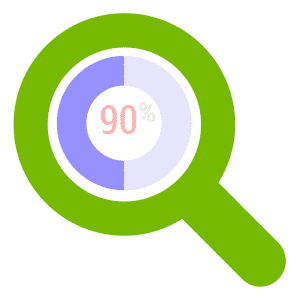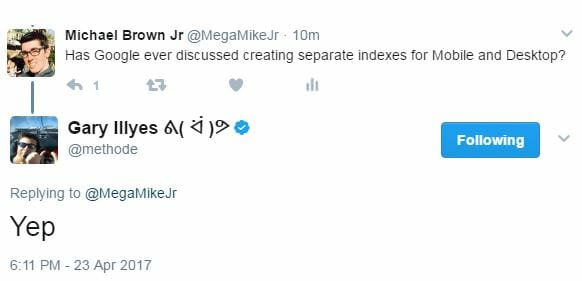Why Did Google Decide Mobile-first Indexing?
People use mobile devices differently than they do desktops. And Google is well-aware of these differences, as well as the growing number of on-the-go searchers who routinely reach from their smartphones and tablets.

But I’m not sure why Google selected to “only” focus on MOBILE?
With that being said, I think you will agree that Google should be investing more in mobile searches.
In fact, mobile has outranked desktop since 2015 and now drives more than half of all online traffic.
More than 90 percent of searchers routinely use a mobile device to search for business info and four out of five consumers use a smartphone to shop.
All of these factors played a role in Google’s decision to adopt a mobile-first approach to indexing. If you’re still on the fence when it comes to mobile first indexing or not sure what it means for your online engagement efforts, take a moment to consider why Google made the move.
So, What Is Mobile First Indexing?
Google began limited roll-outs of its mobile first approach to indexing in 2016 before applying it universally in 2017. Google first discussed the growing use of smartphones and other devices for searching purposes at the Mobile World Congress in 2010.
Since then, Google has slowly moved towards a mobile mentality as the use of such devices has continued to rise. And the reason why they’ve been all about the mobile is because it’s currently how most people get the info they need when they want to find, buy, or know something. Basically, mobile first indexing means:
• Google will view your site the way a mobile user would view it
• Desktop and mobile rankings will be based entirely on mobile signals
• Websites need to be designed for maximum usability from any screen
Follow the Revenue and Ad Spending

Google makes the bulk of its search-related revenue from advertising on either Google websites or on other websites. Nearly 80 percent of all search ad revenue in the U.S. is earned by Google. By 2020, it’s predicted that SEO-based ad spending will be about $80 billion annually and content marketing, in general, will be a $300 billion a year industry.
By 2019, spending on mobile ads alone is expected to account for roughly 70 percent of all digital ad spending, or about $200 billion annually. These are definitely some compelling reasons to shift the focus to mobile searching and ranking.
Desktop and Mobile Signals Are Different
It sometimes makes sense to have two separate sites for desktop and mobile searchers, so why doesn’t Google keep ranking for both at the same time, too? It’s because user signals captured by Google’s algorithms for SEO purposes will be different on desktop and mobile because of the differences in the actions typically taken by searchers.
If you dive further into how mobile and desktop use differs, you’ll see why signals are different.
First of all, mobile devices have no mouse pointers, so there’s tapping and scrolling and no clicking, which changes the way visitors interact with sites.
Second, desktop users almost always surf the Web via their browser. Conversely, nearly 90 percent of smartphone users spend most of their time in apps and less than 15 percent of it in browsers. Mobile use also means:
• Less precision with tapping than clicking
• Decreased desire to type a lot to find things because smaller keyboards are still a pain to use for extensive typing
• An ability to take more actions at once (e.g., users on mobile devices can instantly call if a phone number has a clickable link)
So I presented a question to Gary Illyes to see if there was ever a discussion regarding these concerns. Here is what he had to say:

Google will probably never come out and clearly state everything it considers for ranking purposes and in what proportions factors are weighed. Even so, it’s clear the biggest difference between desktop and mobile is with the technical aspects of the websites produced for each type of visitor. Due to the limited bandwidth and smaller screens on mobile devices, Google looks at things like:
• File sizes
• Site speed and page load times
• How much Flash is used (it was good when desktop ruled, but it’s not so good on mobile devices)
Mobile ‘Environments’ Are Different
The environments where mobile and desktop sites are viewed or used are often very different.
And this has to do with mobile-first how?
Because it’s what people are doing when viewing content online that often drives their actions. For instance, desktop users are often sitting at a desk and typically in an office environment. They’re often solely focused on what they’re doing on the computer.
Mobile websites, on the other hand, can literally be accessed from just about anywhere. People searching on a mobile device are also more likely to be influenced by their environment than desktop users. Users of mobile devices could be sitting at home on the couch or walking through the downtown shopping district looking for a good Italian restaurant to go to for lunch.
When mobile searchers browse, it’s rarely random and without purpose. There’s often an immediate need to know some type of info to make a decision. For this reason, Google wants to present content on results pages that’s tailored to mobile expectations. This means such content needs to:
• Provide personalized answers based on user intent
• Make information immediately accessible and understandable
• Convince and allow users to easily take the desired action (purchase, order, call, tap, share with friends, etc.)
Google Is All About Relevant Content
These differences in behaviors are important because they affect how searchers look for information and determine what they expect to find while searching. And since Google is focused on relevant content these days, it makes perfect sense to present content based on what mobile searchers want.
Of course, the user experience is just as important to Google, so going mobile first doesn’t mean the needs of desktop users will be ignored. An attempt to display relevant content is made with every search performed on Google. They’re just shifting their priorities to the way most people search today.
Page Speed Will Become Even More Important
While definitely worth paying attention to, page speed isn’t yet as important as having a website that has an overall mobile-friendly design. Googles algorithm have always considered the speeds at which users access a website. Now that mobile-first is the “law of the search ranking land” so to speak, expect Google to pay more attention to how fast users can tap, swipe, and scroll, which means Web design and development also has to be done with the mobile searcher in mind.
Google has already shown an increased emphasis on speed with Accelerated Mobile Pages (AMP), an open source initiative that can be used to create “lighter” versions of website pages so they can be accessed faster from mobile devices. Once restricted to news publishers, AMP is now available to all content creators.
There Are Bounce Rate Differences
There’s research suggesting that people tend to spend less time on mobile sites than desktop sites. Because of this, bounce rates tend to be higher on mobile-viewed webpages — by as much as 40 percent, according to one estimate. Mobile devices do generate more visits to websites, but there’s often more engagement (more time spent on sites) than what’s seen with mobile devices.
These stats may seem like an argument against mobile-first. However, it’s actually more of an incentive to shift your approach to producing content for the growing number of mobile searchers and to make that content more appealing and accessible to searchers with shorter attention spans.
Besides, Google is thinking about the bigger picture; and it’s clearly a mobile one since anywhere from 40 to 75 percent of website visitors get there from mobile devices. Part of the reason for the difference in bounce rates may be the fact that many sites still aren’t fully optimized for mobile SEO.
Google Has Already Been Encouraging Mobile-Friendly Websites
In 2014, Google added a mobile usability report to their Webmaster Tools which is now referred to as the Search Engine Console. Mobile-friendly snippet results were soon added to the mix later that same year. By the time 2015 rolled around, Google started using its webmaster tools to identify websites that are useful to mobile searchers.
Google unveiled a mobile-friendly algorithm less than six months after they started identifying sites already making things more accessible to on-the-go users. The company was dropping a lot of digital breadcrumbs by encouraging website designers and businesses to think with a mobile mind. If you look at this gradual progression, the signs all pointed to emergence of mobile-first indexing.
Adapting to a Micro-Moments World
Google introduced the world to the concept of micro-moments in 2015. Referring to the habit of people to instinctively turn to their preferred device, usually a smartphone, for information, micro-moments can be a part of all aspects of life.
Still have any doubts about why Google decided to adopt mobile-first indexing?
Just consider your own micro-moments throughout a typical day.
How many times have you been cooking something and needed to quickly find directions? Have you ever been at an used car lot and wondered whether a sticker claiming that the price stated is really “the lowest in town”?
Micro-moments like this are the things that compel people to reach for their mobile device out of habit. Such behaviors also explain why Google wants to look at the Internet through mobile eyes.
These “I want to know now” moments can be great for both consumers and brands, especially brands that have optimized their website for mobile SEO. Nearly 70 percent of online consumers believe that the relevance and timing of a brand’s message shapes how they perceive that brand.
Making that message easily accessible from mobile devices can help make those perceptions positive. Consider some of the stats that show how micro-moments can lead to the actions searchers typically take from their “portable personal computers”:
• Nearly 70 percent of leisure travelers use smartphones to find travel ideas during their spare moments (standing in line, waiting for a bus)
• More than 90 percent of smartphone users look up info while in the middle of a task (highlighting why there’s an urgency for quick access to info)
• More than 80 percent of smartphone users grab their phone while in a store to determine which product to purchase
Local Searches Are Often Mobile
Take a moment to explore local SEO trends and you’ll find plenty of reasons why Google has gone mobile first. More than 75 percent of the local searches done on mobile devices lead to a purchase within 24 hours. And 80 percent of local searches on mobile devices convert.
There are benefits to making it easier for mobile users to do local searches for both online-based businesses and traditional brick-and-mortar stores with information accessible online. The potential power of a mobile-first mentality is further emphasized when you consider what local searchers are often looking for when Googling from a mobile device:
• 54 percent are looking for business hours
• 50 percent are searching for physical locations of nearby stores
• 53 percent want directions to a store in their immediate area
The Mobile-First Conclusion
Google’s mobile first indexing isn’t intended to “punish” websites that aren’t designed for mobile users. As with all things Google-related, the motives behind the move are to linked to how people are searching for what they need or want online. Just know that there is nothing in the works for rankings and indexing of both mobile and desktop (see Tweet below)

What it does mean for your business is a need to create a good user experience for anyone who visits your site, no matter how they’re getting there or what Internet-connected device they happen to be using at the time. Put yourself in the place of someone seeking you out online and present your content from that perspective and you should be good to go with Google.
What efforts are you making to attract customers on the go? Do you feel Google should have separate indexes and ranking algorithms for mobile and desktop? Share your thoughts or comments about mobile first indexing below.


